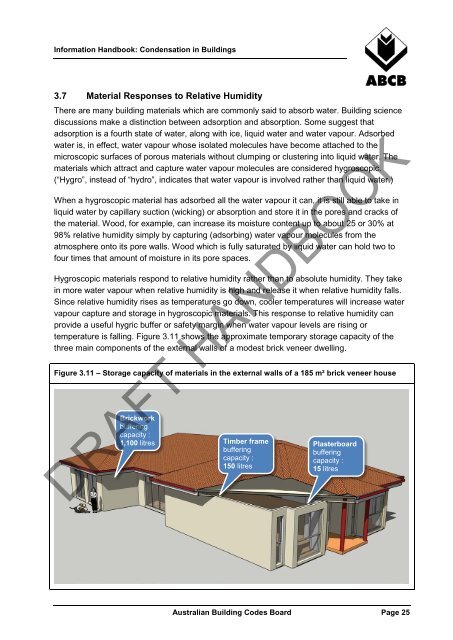Condensation in Buildings - Australian Building Codes Board
Condensation in Buildings - Australian Building Codes Board
Condensation in Buildings - Australian Building Codes Board
Create successful ePaper yourself
Turn your PDF publications into a flip-book with our unique Google optimized e-Paper software.
Information Handbook: <strong>Condensation</strong> <strong>in</strong> Build<strong>in</strong>gs<br />
3.7 Material Responses to Relative Humidity<br />
There are many build<strong>in</strong>g materials which are commonly said to absorb water. Build<strong>in</strong>g science<br />
discussions make a dist<strong>in</strong>ction between adsorption and absorption. Some suggest that<br />
adsorption is a fourth state of water, along with ice, liquid water and water vapour. Adsorbed<br />
water is, <strong>in</strong> effect, water vapour whose isolated molecules have become attached to the<br />
microscopic surfaces of porous materials without clump<strong>in</strong>g or cluster<strong>in</strong>g <strong>in</strong>to liquid water. The<br />
materials which attract and capture water vapour molecules are considered hygroscopic.<br />
(“Hygro”, <strong>in</strong>stead of “hydro”, <strong>in</strong>dicates that water vapour is <strong>in</strong>volved rather than liquid water.)<br />
When a hygroscopic material has adsorbed all the water vapour it can, it is still able to take <strong>in</strong><br />
liquid water by capillary suction (wick<strong>in</strong>g) or absorption and store it <strong>in</strong> the pores and cracks of<br />
the material. Wood, for example, can <strong>in</strong>crease its moisture content up to about 25 or 30% at<br />
98% relative humidity simply by captur<strong>in</strong>g (adsorb<strong>in</strong>g) water vapour molecules from the<br />
atmosphere onto its pore walls. Wood which is fully saturated by liquid water can hold two to<br />
four times that amount of moisture <strong>in</strong> its pore spaces.<br />
Hygroscopic materials respond to relative humidity rather than to absolute humidity. They take<br />
<strong>in</strong> more water vapour when relative humidity is high and release it when relative humidity falls.<br />
S<strong>in</strong>ce relative humidity rises as temperatures go down, cooler temperatures will <strong>in</strong>crease water<br />
vapour capture and storage <strong>in</strong> hygroscopic materials. This response to relative humidity can<br />
provide a useful hygric buffer or safety marg<strong>in</strong> when water vapour levels are ris<strong>in</strong>g or<br />
temperature is fall<strong>in</strong>g. Figure 3.11 shows the approximate temporary storage capacity of the<br />
three ma<strong>in</strong> components of the external walls of a modest brick veneer dwell<strong>in</strong>g.<br />
Figure 3.11 – Storage capacity of materials <strong>in</strong> the external walls of a 185 m² brick veneer house<br />
Brickwork<br />
buffer<strong>in</strong>g<br />
capacity :<br />
1,100 litres Timber frame<br />
buffer<strong>in</strong>g<br />
capacity :<br />
150 litres<br />
Plasterboard<br />
buffer<strong>in</strong>g<br />
capacity :<br />
15 litres<br />
DRAFT HANDBOOK<br />
<strong>Australian</strong> Build<strong>in</strong>g <strong>Codes</strong> <strong>Board</strong> Page 25
















